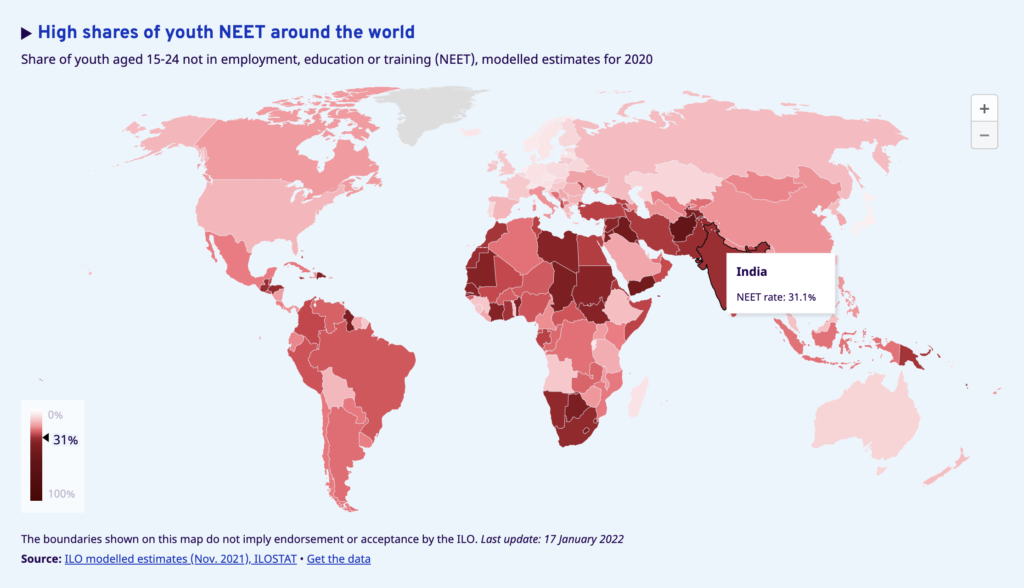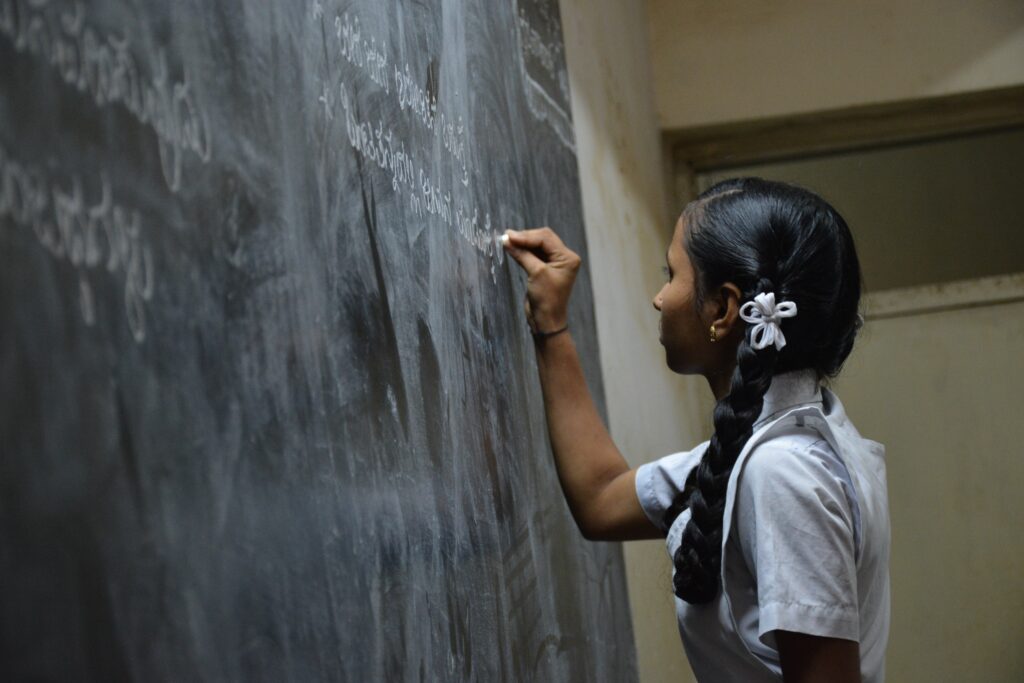How to Solve India’s Unemployability Problem

Did you know India has an unemployability problem in massive proportion? Unemployability is when the people don’t have the skills needed to be employed. This is a more educated youth’s unemployability problem. In this post, let’s deep dive into India’s unemployability problem and how to solve it.
“We need to give importance to skill development because this way we can end unemployment.”
~ Narendra Modi
Contents
Related Posts on How to Solve India’s Unemployability Problem
- 5 Top Reasons for Unemployment in the World
- 6 Top Ways To Find Employment
- Who’s Responsible for Unemployment?
- Why Work is Godliness?
- 12 Best Places to Find Freelance Online Work
India’s Unemployment Problem
As per the Center for Monitoring Indian Economy, the total unemployment rate in August 2022 was 8.3%. That translates to a whopping 35.6 million unemployed.
Source: tradingeconomics.com

Further, the labor participation rate was as low as 39.2% with 430 million in August, 2022. So out of a total population of 1.4 billion people, why are only 430 million people taking part in the labor force?
Among the G20 countries, India has the lowest labor participation rate with the highest in Switzerland as per Trading Economics. It is mind-boggling to see that less than half of India’s population takes part in the labor force.
| Country | Last | Previous | Reference | Unit |
|---|---|---|---|---|
| India | 47.3 | 47.3 | Mar/22 | % |
| Argentina | 47.9 | 46.5 | Jun/22 | % |
| Turkey | 52.6 | 53.2 | Jul/22 | % |
| South Africa | 58.6 | 56.9 | Jun/22 | % |
| Spain | 58.71 | 58.5 | Jun/22 | % |
| Mexico | 60 | 60 | Aug/22 | % |
| Saudi Arabia | 60.4 | 61.5 | Mar/22 | % |
| Russia | 62.3 | 62.3 | Jul/22 | % |
| United States | 62.4 | 62.1 | Aug/22 | % |
| Brazil | 62.7 | 62.6 | Jul/22 | % |
| Japan | 62.9 | 63 | Jul/22 | % |
| South Korea | 64.1 | 64.8 | Aug/22 | % |
| Canada | 64.8 | 64.7 | Aug/22 | % |
| Italy | 65.2 | 65.4 | May/22 | % |
| Australia | 66.6 | 66.4 | Aug/22 | % |
| Singapore | 68.1 | 68 | Dec/20 | % |
| Indonesia | 69.06 | 68.08 | Dec/22 | % |
| France | 73.5 | 73.4 | Jun/22 | % |
| Euro Area | 74.5 | 73.6 | Sep/21 | % |
| Netherlands | 75 | 74.8 | Aug/22 | % |
| United Kingdom | 78.3 | 78.6 | Jun/22 | % |
| Germany | 79.5 | 79.2 | Dec/21 | % |
| Switzerland | 84.2 | 83.8 | Dec/21 | % |
Why is that so? That is primarily because the female labor force participation is abysmally low in India at around 20% (dropped to 19% in 2022) whereas the developed countries are between 50% to 60%.
India’s Youth Unemployment
Moreso, India’s unemployment problem is primarily an unemployability problem of its educated youth. India’s youth aged 15-24 not in employment, education or training (NEET) is 31.1% modeled for 2020 as per ILOSTAT data.

Why Are India’s Youth Unemployable?
So now let’s get into why over 30% of India’s youths are unemployable. There are a variety of reasons.
Fewer Job Opportunities
The foremost is that there are too many educated youths available compared to the number of opportunities available. So naturally a significant portion of the youths are unemployable and therefore unemployed. In 2019, India awarded undergraduate degrees to 6.7 million youths. So is India able to generate 6.7 million jobs every year to absorb its graduates? The economic survey says India generated an average 4.36 million jobs yearly from 2011 to 2018 per an article published in Mint. Thus, there is a gap of over 2 million every year who end up being unemployed.

No Work Experience
The other major reason for unemployability is that Indian youth don’t have any work experience prior to getting into a formal workforce. This is primarily because in India there are not much internship opportunities for youth either when they are in high school or in college. For example, in the US, it is common for students to get some internship experience. It is something that is often arranged by the high schools and strongly supported by industry for students in undergrad school.
Inadequate Job Skills
Then Indian youth don’t have adequate job skills. This is primarily because the school curriculum is outdated and focuses less on the application of theory in the contemporary industry. So students study the theory but lack the understanding since they don’t learn how to apply it in practice. In the US, the education system is very application oriented, wherein students learn through real life case studies from industries. This is the primary gap of the Indian education system, which still has a log way to reform.
Further Indian education system lacks teaching contemporary courses in line with industry demand either as electives or specializations. This is a lot more prevalent in the US compared to India. The focus in the US is to get student’s job ready either regarding introducing courses, helping with internships, or partnering with industry to provide relevant preemployment industry experiences. This is mostly not the case in India. Thus, students are not job ready when they graduate in terms of skills or preparedness.
Attitude Towards Work
This is a more culturally ingrained problem in India, which could relate to its age old caste system. They don’t equally respect all work in India. So when you graduate and if don’t get a more skilled salaried job and you decide to work in the informal sector, say in a store, then the society doesn’t treat you with due respect. People may think you are doing a lowly job that is beneath your dignity. This is a real problem in India. Not all work is equally respected.
No Hourly Jobs in the Formal Sector
Last, India doesn’t have a formal hourly jobs sector. Like in the US, almost all job is formal, meaning you get a pay through a paycheck and not paid in cash. Salaried jobs in India are mostly formal but there are still salaried jobs wherein the employer may pay in cash with no proof of employment and no benefits like medical or provident fund (retirement benefit). Jobs in the informal sector don’t have any benefits and are mostly daily wage earners. There is no hourly formal job system in India. So because of this graduates wait for a formal salaried job and until then prefer to stay unemployed. Since getting into a daily wage earner job is below their dignity or just too backbreaking to consider just after graduation.
How to Solve India’s Unemployability Problem

Then how can India solve its unemployability problem? There are of course several reforms that the government needs to pursue to transform the job market from informal to formal, as well as generate additional job opportunities. But apart from what the government needs to do, what can fresh graduates do to increase their employability?
First, graduates need to get into the workforce as early as possible and accept jobs that may not be their dream job, or even if the pay is too low. If one is not doing any job, they will not get the job experience which employers are looking for. So they will lose on getting the formal salaried job that they yearn for.
Second, it is a more cultural transformation for India that no work is low beneath anyone’s dignity. Work is godliness. This will not happen overnight, but for fresh graduates, they would need to break cultural misconceptions and take the lead to bring about a cultural change toward the better.
Third, students need to stay apprised of market skill demands and either self study to learn or get external certifications for job ready skills. The onus is on the students or fresh graduates to learn market demand skills. For students with financial constraints, there are a lot of opportunity to gain these skills free over the internet online. One needs to take the ownership and initiative.
Conclusion on How to Solve India’s Unemployability Problem
Thus, in conclusion on how to solve India’s unemployability problem, both the Indian government and Indians need to make significant strides in terms of reforms. India is a country of 1.4 billion people with a relatively young population. It has one of the highest percentage of its population in the working age group 15-64 years, about 39.1% of the population. This is a huge demographic advantage for India and it needs to take advantage of it to propel its economy and bring millions out of poverty.

Leave a Reply
You must be logged in to post a comment.